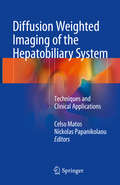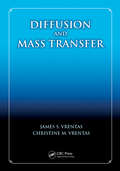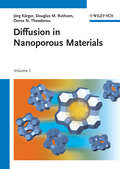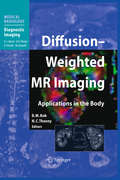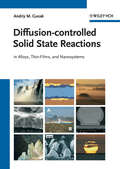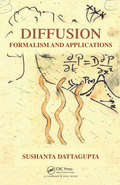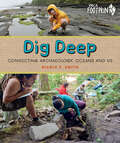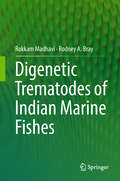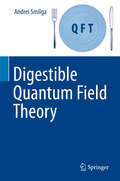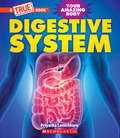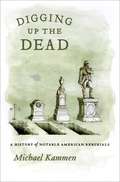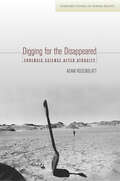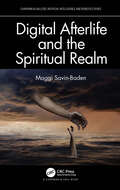- Table View
- List View
Diffusion Weighted Imaging of the Genitourinary System: Techniques And Clinical Applications
by Deniz Akata Nikolaos PapanikolaouThis book discusses diffusion weighted imaging (DWI) and its evolving clinical role. DWI has frequently been used in the abdomen and pelvis but is now increasingly being used in other clinical applications, especially for the diagnostic workup of oncologic patients. Standardization and clinical validation of quantitative DWI related biomarkers is still ongoing, although efforts have been undertaken, especially in the prostate, to provide standardized imaging guidelines for different clinical indications. The technical aspects and clinical applications of DWI presented focus on the respective anatomical region and its pathologies. The book is unique in providing tables of technical details (imaging protocols, artifacts, optimization techniques) for each chapter, making this complex area as simple and practical as possible.The book is intended for radiologists interested in urogenital radiology and also for radiology residents.
Diffusion Weighted Imaging of the Hepatobiliary System: Techniques and Clinical Applications
by Celso Matos Nickolas PapanikolaouThis book presents the core principles and technical aspects of Diffusion Weighted Imaging (DWI), as well as pearls and pitfalls concerning the imaging technique’s application to the hepatobiliary system. All technical aspects and clinical applications discussed focus on the related anatomical region and its pathologies.Given that magnetic resonance physics is complex and can be cumbersome to learn, the volume editors and authors have made it as simple and practical as possible. Accordingly, tables related to technical details (imaging protocols, artefacts, and optimization techniques) are provided for each chapter.Though DWI is frequently used in the abdomen and pelvis, its clinical role is still evolving, especially for the diagnostic workup of oncologic patients. Although certain efforts have been undertaken to standardize and provide imaging guidelines for different clinical indications, the standardisation and clinical validation of quantitative DWI-related biomarkers are still works in progress. Addressing this gap, the book offers a useful tool for radiologists with a particular interest in abdominal radiology, as well as for radiology residents.
Diffusion and Mass Transfer
by James S. Vrentas Christine M. VrentasA proper understanding of diffusion and mass transfer theory is critical for obtaining correct solutions to many transport problems. Diffusion and Mass Transfer presents a comprehensive summary of the theoretical aspects of diffusion and mass transfer and applies that theory to obtain detailed solutions for a large number of important problems. Par
Diffusion in Ceramics
by Joshua PellegThis textbook provides an introduction to changes that occur in solids such as ceramics, mainly at high temperatures, which are diffusion controlled, as well as presenting research data. Such changes are related to the kinetics of various reactions such as precipitation, oxidation and phase transformations, but are also related to some mechanical changes, such as creep. The book is composed of two parts, beginning with a look at the basics of diffusion according to Fick's Laws. Solutions of Fick's second law for constant D, diffusion in grain boundaries and dislocations are presented along with a look at the atomistic approach for the random motion of atoms. In the second part, the author discusses diffusion in several technologically important ceramics. The ceramics selected are monolithic single phase ones, including: A12O3, SiC, MgO, ZrO2 and Si3N4. Of these, three refer to oxide ceramics (alumina, magnesia and zirconia). Carbide based ceramics are represented by the technologically very important Si-carbide and nitride based ceramics are represented by Si-nitride which has been important in high temperature ceramics and gas turbine applications. The author presents a clear, concise and relatively comprehensive treatment of diffusion in ceramics for use by those at an advanced undergraduate level and beyond. It supports understanding of the basic behavior of materials and how to relate observed physical properties to microscopic understanding. The book also provides researchers with a handy collation of data relating to diffusion in ceramics and supports a fundamental understanding of atomic movements.
Diffusion in Nanoporous Materials
by Doros N. Theodorou Jörg Kärger Douglas M. RuthvenAtoms and molecules in all states of matter are subject to continuous irregular movement. This process, referred to as diffusion, is among the most general and basic phenomena in nature and determines the performance of many technological processes. This book provides an introduction to the fascinating world of diffusion in microporous solids. Jointly written by three well-known researchers in this field, it presents a coherent treatise, rather than a compilation of separate review articles, covering the theoretical fundamentals, molecular modeling, experimental observation and technical applications. Based on the book Diffusion in Zeolites and other Microporous Solids, originally published in 1992, it illustrates the remarkable speed with which this field has developed since that time. Specific topics include: new families of nanoporous materials, micro-imaging and single-particle tracking, direct monitoring of transient profiles by interference microscopy, single-file diffusion and new approaches to molecular modeling.
Diffusion in Solids: Field Theory, Solid-State Principles, and Applications
by Martin Eden GlicksmanThis book offers a modern treatment of diffusion in solids, covering such core topics as the transport of mass through the lattice of a crystalline solid. Part I of the book develops basic concepts in diffusion field theory and illustrates them with several applications, while Part II focuses on key solid-state principles needed to apply diffusion theory to real materials.
Diffusion-Weighted MR Imaging
by Harriet C. Thoeny Dow-Mu KohThe clinical applications of diffusion-weighted MR imaging (DW-MRI) in the body are rapidly evolving. This volume highlights state-of-the-art techniques for performing DW-MRI measurement in the body and addresses important practical issues. Key points are highlighted that will help radiologists and technologists to acquire high-quality images for disease assessment and to adapt the technique to their own clinical practice or research. The major clinical applications of DW-MRI in the body, both oncological and non-oncological, are extensively illustrated, providing readers with a broad insight into the growing uses of the technique. The final section addresses future developments, considering the potential importance of the technique in relation to drug development and the ways in which DW-MRI might be combined with other functional imaging techniques to further improve disease assessment.
Diffusion-controlled Solid State Reactions: In Alloys, Thin Films and Nanosystems
by Andriy M. Gusak A. S. Shirinyan T. V. Zaporozhets Yu. O. Lyashenko M. O. Pasichnyy S. V. KornienkoWritten by an outstanding group of applied theoreticians with comprehensive expertise and a wide spectrum of international contacts headed by Prof. A. M. Gusak, this monograph coherently presents the approaches and results hitherto only available in various journal papers. A must-have for all those involved with the public or corporate science of nano systems, thin films and electrical engineering.
Diffusion: Formalism and Applications
by Sushanta DattaguptaWithin a unifying framework, Diffusion: Formalism and Applications covers both classical and quantum domains, along with numerous applications. The author explores the more than two centuries-old history of diffusion, expertly weaving together a variety of topics from physics, mathematics, chemistry, and biology. The book examines the two distinct
Diffusionics: Diffusion Process Controlled by Diffusion Metamaterials
by Ji-Ping Huang Fu-Bao YangThis open access book presents a comprehensive exploration of diffusion metamaterials that control energy and mass diffusion. Currently, if from the perspective of governing equations, diffusion metamaterials and wave metamaterials (pioneered by J. B. Pendry in the 1990s) are recognised as the two most prominent branches in the field of metamaterials. These two branches differ in their emphasis on the diffusion equation (as the governing equation) and time-dependent characteristic lengths in diffusion metamaterials, as opposed to the wave equation (as the governing equation) and time-independent characteristic lengths in wave metamaterials. Organized into three distinct parts – 'Thermal Diffusion Metamaterials', 'Particle Diffusion Metamaterials', and 'Plasma Diffusion Metamaterials' – this book offers a rigorous exploration spanning physics, engineering, and materials science, aimed at advancing our understanding of diffusion processes controlled by diffusion metamaterials. Incorporating foundational theory, computational simulations, and laboratory experiments, the book equips researchers and scholars across these disciplines with comprehensive methods, insights, and results pivotal to the advancement of diffusion control. Beyond facilitating interdisciplinary discourse, the book serves as a catalyst for innovative breakthroughs at the crossroads of physics, thermodynamics, and materials science. Essentially, readers will acquire profound insights that empower them to spearhead advancements in diffusion science (diffusionics) and the engineering of metamaterials.
Diffusive Gradients in Thin-Films for Environmental Measurements (Cambridge Environmental Chemistry Series)
by William DavisonThe diffusive gradients in thin-films (DGT) technique is a means of measuring the concentration and speciation of metals in natural waters. Edited by one of the pioneers of the technique, this unique volume provides a complete and authoritative guide to the theory and applications of DGT. The book includes explanations of the fundamental principles of DGT, accessible to readers with a modest background in chemistry, as well as more advanced chapters that provide a thorough treatment of the physical and chemical dynamics of this technique and evaluate how well it mimics the biological uptake process. Chapters on natural waters, soils and sediments illustrate the applications of DGT, and detailed instructions are included on how to use DGT in practice. Combining the fundamentals of DGT with more advanced principles, this is an indispensable text for students, researchers and professional scientists interested in the chemistry of natural waters, soils and sediments. Provides a coherent and detailed account of the applications and uses of this valuable technique, ensuring that readers are fully initiated into all aspects of this emerging tool Edited by a world-leading expert on DGT, ensuring firsthand information and accurate, up-to-date research Includes a chapter on practical uses of DGT encouraging the reader to master this technique themselves, aiding the readers' own research and furthering their understanding of these processes on a practical level
Diffusive Spreading in Nature, Technology and Society
by Armin Bunde Jörg Kärger Jürgen Caro Gero Vogl Christian ChmelikWhat do the movements of molecules and the migration of humans have in common? How does the functionality of our brain tissue resemble the flow of traffic in New York City? How can understanding the spread of ideas, rumors, and languages help us tackle the spread a pandemic? This book provides an illuminating look into these seemingly disparate topics by exploring and expertly communicating the fundamental laws that govern the spreading and diffusion of objects. A collection of leading scientists in disciplines as diverse as epidemiology, linguistics, mathematics, and physics discuss various spreading phenomena relevant to their own fields, revealing astonishing similarities and correlations between the objects of study—be they people, particles, or pandemics.This updated and expanded second edition of an award-winning book introduces timely coverage of a subject with the greatest societal impact in recent memory—the global fight against COVID-19. Winner of the 2019 Literature Prize of the German Chemical Industry Fund, this book targets an interdisciplinary readership, featuring an introductory chapter that sets the stage for the topics discussed throughout. Each chapter provides ample opportunity to whet the appetite of those readers seeking a more in-depth treatment, making the book also useful as supplementary reading in appropriate courses dealing with complex systems, mass transfer, and network theory.
Dig Deep: Connecting Archaeology, Oceans and Us (Orca Footprints #25)
by Nicole F. SmithKey Selling Points This book looks at how we can learn from the past to help our oceans today and into the future. It draws on recent archaeological findings from around the world and engages readers in a variety of STEAM topics. The book emphasizes the importance of honoring Indigenous Traditional Knowledge in our understanding of the past and present. It highlights examples of Indigenous cultural heritage and shows young readers that there are many ways of knowing and understanding the world around us. Invites kids to ask questions about their archeological footprint, how it affects the world’s oceans and what it can tell us about the effects of climate change. The author is a working archaeologist with over 20 years of experience and a focus on clam gardens, fish traps, stone tools, archaeological sites over 10,000 years old, and the effects of climate change and sea-level rise on cultural heritage. Dig Deep was read by a number of expert readers, including archaeologists and an Indigenous authenticity reader to ensure it reflected Indigenous ways of knowing.
Dig It!: An Earth and Space Science Unit for High-Ability Learners in Grade 3
by Clg Of William And Mary/Ctr Gift EdDig It!, a third-grade Earth and space science unit, encourages students to investigate humanity's effects on the environment and the importance of conserving natural resources. The unit builds upon students' prior knowledge and the overarching concept of change by providing opportunities to relate local examples of environmental pollution and conservation with hands-on scientific experiments and demonstrations.Dig It! was developed by the Center for Gifted Education at The College of William and Mary to offer advanced curriculum supported by years of research. The Center's materials have received national recognition from the United States Department of Education and the National Association for Gifted Children, and they are widely used both nationally and internationally.Each of the books in this series offers curriculum that focuses on advanced content and higher level processes. The science units contain simulations of real-world problems, and students experience the work of real science by using data-handling skills, analyzing information, and evaluating results. The mathematics units provide sophisticated ideas and concepts, challenging extensions, higher order thinking skills, and opportunities for student exploration based on interest. These materials are a must for any teacher seeking to challenge and engage learners and increase achievement.Grade 3
Dig Those Dinosaurs
by Lori Haskins Houran Francisca MarquezRhythmical story text and illustrations follow a paleontologist and his crew as they dig, assemble, and exhibit dinosaur bones."Dig, dig, dig those dinosaurs/ So big, big, big those dinosaurs/ Rig, rig, rig those dinosaurs/ Dig those dinosaur bones."The rhythmical text and lively, well-researched illustrations follow a paleontologist and his crew as they find, clean, assemble, and exhibit dinosaur bones. The read-aloud fun is accompanied by up-to-date facts about dinosaur fossils. Educational and inspiring, this story is bound to captivate little scientists.This is a fixed-format ebook, which preserves the design and layout of the original print book.
Digenetic Trematodes
by Rafael Toledo Bernard FriedDigenetic trematodes constitute a major helminth group that parasitize humans and animals, and are a major cause of morbidity and mortality. The diseases caused by trematodes have been neglected for years, especially as compared with other parasitic diseases. However, the geographical limits and the populations at risk are currently expanding and changing in relation to factors such as growing international markets, improved transportation systems, and demographic changes. This has led to a growing international interest in trematode infections, although factors such as the difficulties entailed in the diagnosis, the complexity of human and agricultural practices, the lack of assessments of the economic costs or the limited number of effective drugs are preventing the development of control measures of these diseases in humans and livestock. In-depth studies are needed to clarify the current epidemiology of these helminth infections and to identify new and specific targets for both effective diagnosis and treatments. The main goal of this book is to present the major trematodes and their corresponding diseases in the framework of modern parasitology, considering matters such as the application of novel techniques and analysis of data in the context of host-parasite interactions and to show applications of new techniques and concepts for the studies on digenetic trematodes. This is an ideal book for parasitologists, microbiologists, zoologists, immunologists, professional of public health workers, clinicians and graduate and post-graduate students.
Digenetic Trematodes (Advances in Experimental Medicine and Biology #1154)
by Rafael Toledo Bernard FriedDigenetic trematodes constitute a major helminth group that parasitize human and animals and are a major cause of morbidity and mortality. The diseases caused by trematodes have been neglected for years, especially as compared with other parasitic diseases. However, the geographical limits and the populations at risk are currently expanding and changing in relation to factors such as growing international markets, improved transportation systems, and demographic changes. This has led to a growing international interest to the trematode infections, although factors such as the difficulties entailed in the diagnosis, the complexity of human and agricultural practices, the lack of assessments of the economic costs, or the limited number of effective drugs are preventing the development of control measures of these diseases in humans and livestock. In-depth studies are needed to clarify the current epidemiology of these helminth infections and to identify new and specific targets for both effective diagnosis and treatments. The main goal of the second edition of this book is to present the major trematodes and their corresponding diseases in the framework of modern parasitology, considering matters such as the application of novel techniques and analysis of data in the context of host-parasite interactions and to show applications of new techniques and concepts for the studies on digenetic trematodes. This is an ideal book for parasitologists, microbiologists, zoologists, immunologists, professional of public health workers, clinicians and graduate and post-graduate students.
Digenetic Trematodes (Advances in Experimental Medicine and Biology #1454)
by Rafael Toledo Bernard FriedAlthough digenetic trematodes have been largely neglected, they constitute a major group of helminths that parasitize human and animals causing significant morbidity and mortality. This is of special importance today, since the geographical limits and the populations at risk, traditionally limited to developing or low-income countries, are currently expanding and changing in relation to factors such as growing international markets, improved transportation systems, and demographic changes. This has led to a growing international interest in trematode infections, although factors such as the difficulties entailed in the diagnosis, the complexity of human and agricultural practices, the lack of assessments of economic costs, or the limited number of effective drugs are preventing the development of control measures of these diseases in humans and livestock. In-depth studies are needed to clarify the current epidemiology of these helminth infections and to identify new and specific targets for both effective diagnosis and treatments. The main goal of the third edition of this book is to present the major trematodes and their corresponding diseases in the framework of modern parasitology, considering matters such as the application of novel techniques and analysis of data in the context of host-parasite interactions and also with the resident microbiota, showing the application of modern techniques and concepts to the studies on digenetic trematodes. This is an ideal book for parasitologists, microbiologists, zoologists, immunologists, public health professionals, clinicians and graduate and post-graduate students.
Digenetic Trematodes of Indian Marine Fishes
by Rokkam Madhavi Rodney A. BrayThis book is the first to explore in detail the systematics and taxonomy of the digenean fauna of fish in Indian marine waters. It includes morphological descriptions of 648 species in 190 genera and 30 families. The figures from the original publications are enhanced and made more attractive. Each description is accompanied by information on hosts and distribution. Digenetic trematodes, usually known as Digeneans, are the most diverse group of metazoan parasites of marine fishes. They are parasitic flatworms (Phylum Platyhelminthes) with a complex life-cycle and as adults inhabit mainly the alimentary system and associated organs, but also occur in the blood, under the scales, in the body cavity and in the gall and urinary bladders. Keys to families, genera and species are provided, except for a few large and controversial genera, where morphological characters are insufficient for identification. Although there is extensive literature on Digeneans, it is scattered and largely in obscure local journals. Bringing together most of the primary literature on the subject, this book provides a primer for further study and a starting point for the use of modern molecular methods for the fauna of this region. Unique in its scope, it is a valuable resource for students, professional parasitologists and ecologists as well as fishery and wildlife biologists.
Digestible Quantum Field Theory
by Andrei SmilgaThis book gives an intermediate level treatment of quantum field theory, appropriate to a reader with a first degree in physics and a working knowledge of special relativity and quantum mechanics. It aims to give the reader some understanding of what QFT is all about, without delving deep into actual calculations of Feynman diagrams or similar. The author serves up a seven‐course menu, which begins with a brief introductory Aperitif. This is followed by the Hors d'oeuvres, which set the scene with a broad survey of the Universe, its theoretical description, and how the ideas of QFT developed during the last century. In the next course, the Art of Cooking, the author recaps on some basic facts of analytical mechanics, relativity, quantum mechanics and also presents some nutritious "extras" in mathematics (group theory at the elementary level) and in physics (theory of scattering). After these preparations, the reader should have a good appetite for the Entr#65533;es ‐ the central par t of the book where the Standard Model is described and explained. After Trou Normand, the restive pause including human stories about physicists and no formulas, the author serves the Dessert, devoted to supersymmetry (a very beautiful theory that is still awaiting a direct experimental confirmation), to general relativity and to the mystery of quantum gravity.
Digestive System (A True Book (Relaunch))
by Priyanka LamichhaneDiscover the main systems of our amazing human body with this new series of books!Digestion starts the minute you put food or a drink in your mouth. And by the time the process ends, your body has taken every bit of nutrition possible from your food. Did you know that the average person produces enough saliva in one year to fill a bathtub? Or that the small intestine is the longest part of the digestive system? Learn all this and more in Digestive System.ABOUT THE SERIES:The human body is a complex ⹀ and remarkable ⹀ machine. Digesting our food. Pumping our blood. Walking, running, and dancing. It takes our many body systems working together to keep us alive and living our lives to the fullest. This set of A True Books offers an in-depth look at our amazing bodies ⹀ one system at a time. Interesting information is presented in a fun, friendly way ⹀ and in the simplest terms possible ⹀ giving students a "behind-the-scenes" look at how their bodies work.
Digging Up the Dead: A History of Notable American Reburials
by Michael G. KammenA funeral closes a life story, and a grave in a cemetery marks its end forever. But what happens when those left behind don't agree about the meaning of that story? Or when that disagreement extends all the way to arguments about the final resting place itself? In a surprising number of cases over the years, that's when people have chosen to grab shovels and start digging. With Digging Up the Dead, Pulitzer Prize-winning historian Michael Kammen reveals a treasure trove of fascinating, surprising, and sometimes gruesome stories of exhumation and reburial from throughout American history. Taking us to the contested grave sites of such figures as Sitting Bull, John Paul Jones, Frank Lloyd Wright, Daniel Boone, Jefferson Davis, and even Abraham Lincoln, Kammen explores how complicated interactions of regional pride, shifting reputations, and evolving burial practices led to public, often emotional battles over the final resting places of famous figures. Grave-robbing, skull-fondling, cases of mistaken identity, and the financial lures of cemetery tourism all come into play as Kammen delves deeply into this little-known- yet surprisingly persistent- aspect of American history. Simultaneously insightful and interesting, masterly and macabre, Digging Up the Dead reminds us that the stories of American history don't always end when the key players pass on. Rather, the battle- over reputations, interpretations, and, last but far from least, possession of the remains themselves- is often just beginning.
Digging for the Disappeared: Forensic Science after Atrocity
by Adam RosenblattThe mass graves from our long human history of genocide, massacres, and violent conflict form an underground map of atrocity that stretches across the planet's surface. In the past few decades, due to rapidly developing technologies and a powerful global human rights movement, the scientific study of those graves has become a standard facet of post-conflict international assistance. Digging for the Disappeared provides readers with a window into this growing but little-understood form of human rights work, including the dangers and sometimes unexpected complications that arise as evidence is gathered and the dead are named. Adam Rosenblatt examines the ethical, political, and historical foundations of the rapidly growing field of forensic investigation, from the graves of the "disappeared" in Latin America to genocides in Rwanda and the former Yugoslavia to post-Saddam Hussein Iraq. In the process, he illustrates how forensic teams strive to balance the needs of war crimes tribunals, transitional governments, and the families of the missing in post-conflict nations. Digging for the Disappeared draws on interviews with key players in the field to present a new way to analyze and value the work forensic experts do at mass graves, shifting the discussion from an exclusive focus on the rights of the living to a rigorous analysis of the care of the dead. Rosenblatt tackles these heady, hard topics in order to extend human rights scholarship into the realm of the dead and the limited but powerful forms of repair available for victims of atrocity.
Digital Afterlife and the Spiritual Realm (Chapman & Hall/CRC Artificial Intelligence and Robotics Series)
by Maggi Savin-BadenFew religious leaders have examined the potential for the positive impact of digital media and digital immortality creation in religious contexts. It is evident that there have been recent moves away from traditional funeral services focusing on the transition of the deceased into the future world beyond, towards a rise of memorial content within funerals and commemorative events. This has heralded shifts in afterlife beliefs by replacing them, to all intents and purposes, by attitudes to this life. Digital Afterlife and the Spiritual Realm explores the ways in which digital media and digital afterlife creation affects social and religious understandings of death and the afterlife. Features Understands the impact of digital media on those living and those working with the bereaved Explores the impact of digital memorialisation post death Examines the ways in which digital media may be changing conceptions and theologies of death For many people, digital afterlife and the spiritual realm largely remains an area that is both inchoate and confusing. This book will begin to unravel some of this bafflement.
Digital Agriculture: A Solution for Sustainable Food and Nutritional Security
by P. M. Priyadarshan Shri Mohan Jain Jameel M. Al-Khayri Suprasanna PennaThe world population is increasing while arable land is decreasing at an alarming rate. About one-quarter of arable land is degraded and needs significant restoration before it can sustain crops again. By 2030, the water supply will fall 40% short of meeting global demand. Moreover, looming climate change poses additional challenge to increasing food production to feed 10 billion people by 2050. Current major agricultural systems are on a largely unsustainable trajectory because of their contributions to greenhouse gas emissions, water pollution, and biodiversity loss.For these reasons, innovative technologies are being introduced in modern agriculture to sustain food production. They include digital and geospatial technologies to manage soil, climate and plant genetic resources. With the development of tools and sensors integrated into the internet of things (IoT) environment, physically collected information is converted into computer-readable language. Digital innovations thus allow real-time analysis, machine learning, and artificial intelligence (AI) that manage massive amount of data, also known as big data. Accordingly, digital agriculture affords greater potential for sustainable farming and economic benefits. This book summarizes the latest advances in AI-integration of agriculture practices. Specific focus includes but not limited to, big data, yield mapping, pests management, and optimal fertigation. As such, it presents a forward-looking approach to meet multiple UN Sustainable Development Goals, specifically, SDG 2, 6, 13 and 15.

